Please login or click here to join.
Forgot Password? Click Here to reset pasword
 |
Small White (Pieris Rapae) Male on Knapweed in Whiteley Woods The Small White is one of the most widespread of our butterflies and can be seen literally anywhere in the British Isles. Unfortunately for the Small White it shares the acronym of 'Cabbage White' with its larger cousin, although the damage caused by this species is significantly less than that of the Large White. This picture appears in the following picture tours: |
 |
Silver Y Moth in Whiteley Woods The Silver Y is our most common immigrant moth and is easily identified with a prominent silver Y marking on each forewing, standing out against a dull grey or buff brown background. It is seen mainly in late summer, throughout the entire UK, even in coastal areas and flies by day or night. This picture appears in the following picture tours: Camera Make: NIKON CORPORATION� Model: NIKON D800� |
 |
Red Admiral (Vanessa Atalanta) Male, Freshly Emerged from its Chrysalis Probably the most recognised and popular butterfly in Britain, although the Red Admiral is mainly a migrant from central Europe. A small percentage of the population are resident in the south of England, but most arrive in May & June and can be found anywhere in the British Isles, even Shetland and Orkney. This picture appears in the following picture tours: |
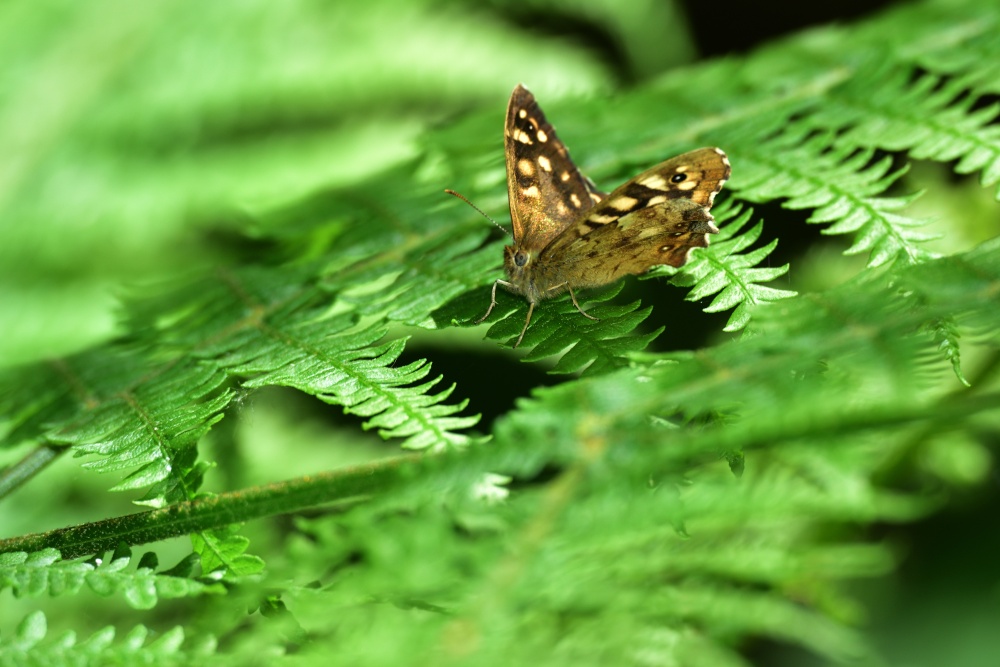 |
Speckled Wood on a Fern Frond in Whiteley Woods The Speckled Wood (Pararge aegeria) is one of our most common woodland butterflies, often seen at the edge of paths, tracks and hedgerows, as well as on Ferns as in this shot. Its range is throughout the British Isles, although somewhat patchy in some areas, particularly the north of England and the south of Scotland. This picture appears in the following picture tours: |
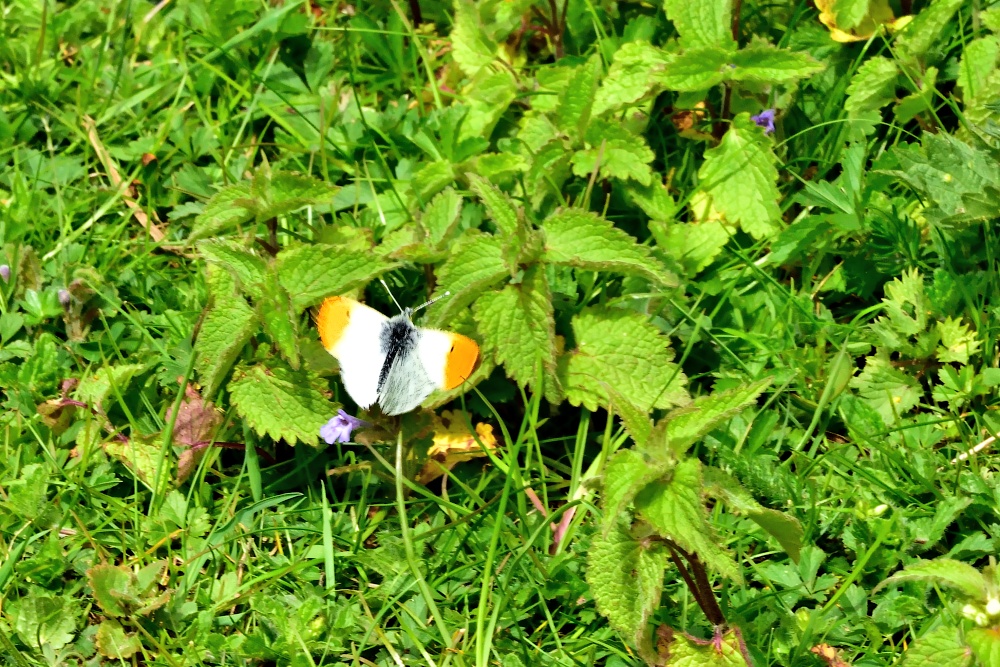 |
Orange-tip (Anthocharis Cardamines) Male in Whiteley Woods The Orange-tip is common in England and Wales, but more localized the further north you go and largely absent from Scotland. It is one of the few species that don't form colonies, but wander aimlessly along hedgerows and woodland margins to find their food and mates. This picture appears in the following picture tours: |
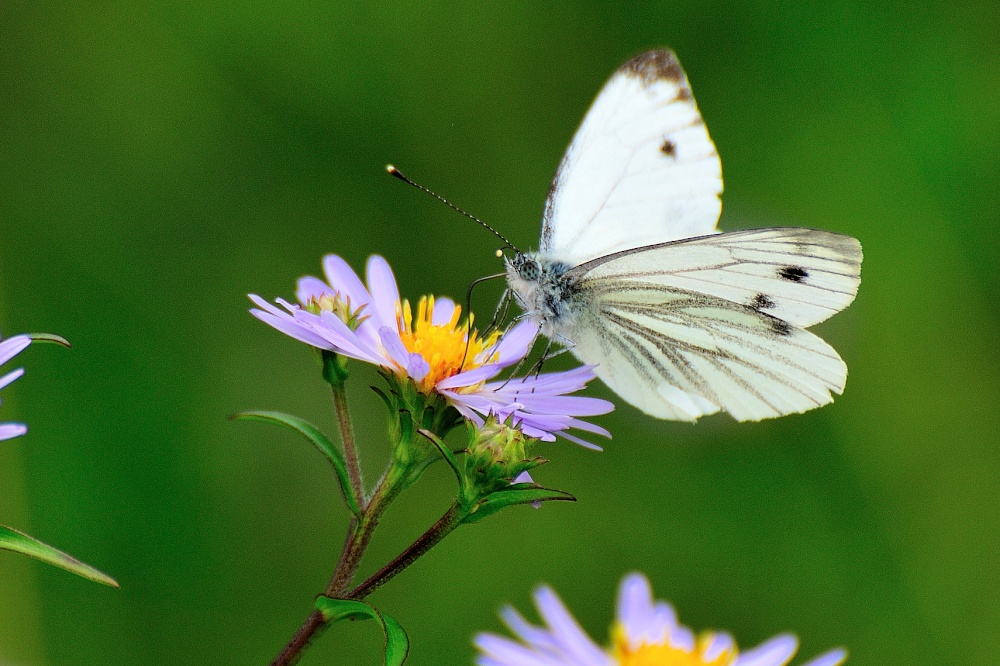 |
Green-veined White (Pieris Napi) Female in Whiteley Woods The Green-veined White is one of our most common butterflies and is often mistaken for its close cousin the Small White. They are seen from Spring through to Autumn in parks and gardens, as well as woodlands and meadows. The greenish lines on the underwings are not actually veins, but are coloured wing scales, just as those giving all butterflies their many and various colours. This picture appears in the following picture tours: |
 |
Dark Green Fritillary (Speyaria Aglaja) Male in Whiteley Woods We don't seen many Fritillaries in Whiteley Woods, although we do see a few of Britain's most common one, the Dark Green Fritillary. The woodland is adjacent to a large meadow and the whole area has a good supply of the Fritillary's main food source, thistles and Knapweed. This picture appears in the following picture tours: |
 |
Gatekeeper (Pyronia Tithonus) in Whiteley Woods The Gatekeeper is common in Most of England and Wales, although it appears to reach the northern limit of its preferred climate in South Yorkshire and is absent from Scotland. Within their range Gatekeepers are a common site at the edge of woodland paths and tracks, where they patrol close to the ground. This picture appears in the following picture tours: |
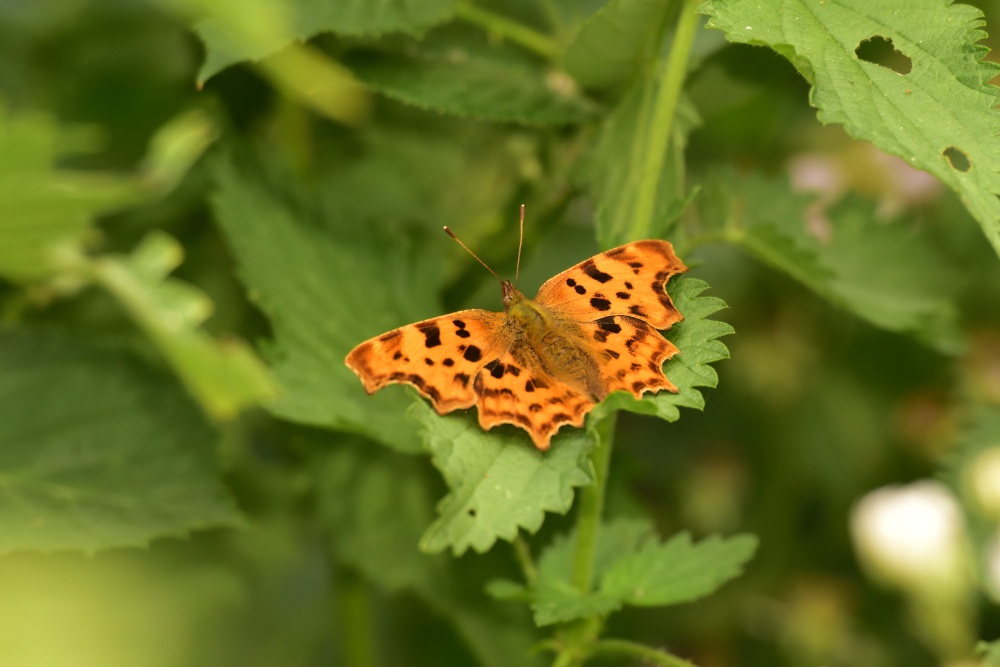 |
Comma Butterfly (Polygonia c-album) Male in Whiteley Woods The Comma is a common sight in most of England and Wales and is one of the few species currently expanding its range. Its name comes from a small white comma shaped marking on the underwing, which is clear to see against its dark brown and black background, if only the butterfly would close its wings. Unfortunately the Comma is almost unique in opening its wings out flat immediately, almost every time it lands. This picture appears in the following picture tours: |
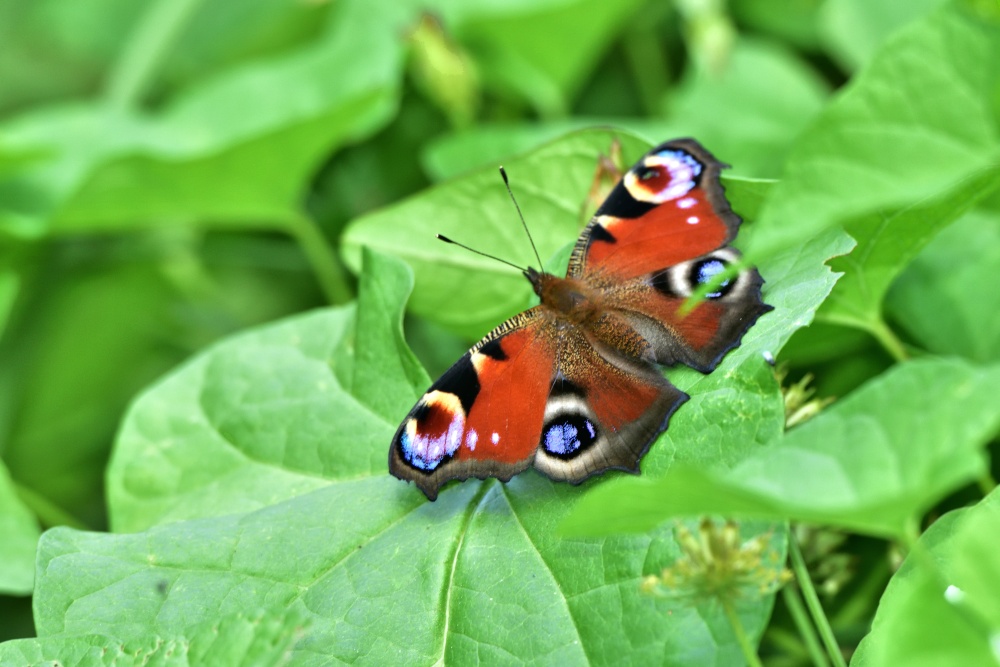 |
Peacock (Aglais io) Male Sunning Itselfin Whiteley Woods The Peacock butterfly is common throughout the entire British Isles and is equally unmistakeable, due to the 'eyes' that it is named for. This picture appears in the following picture tours: |
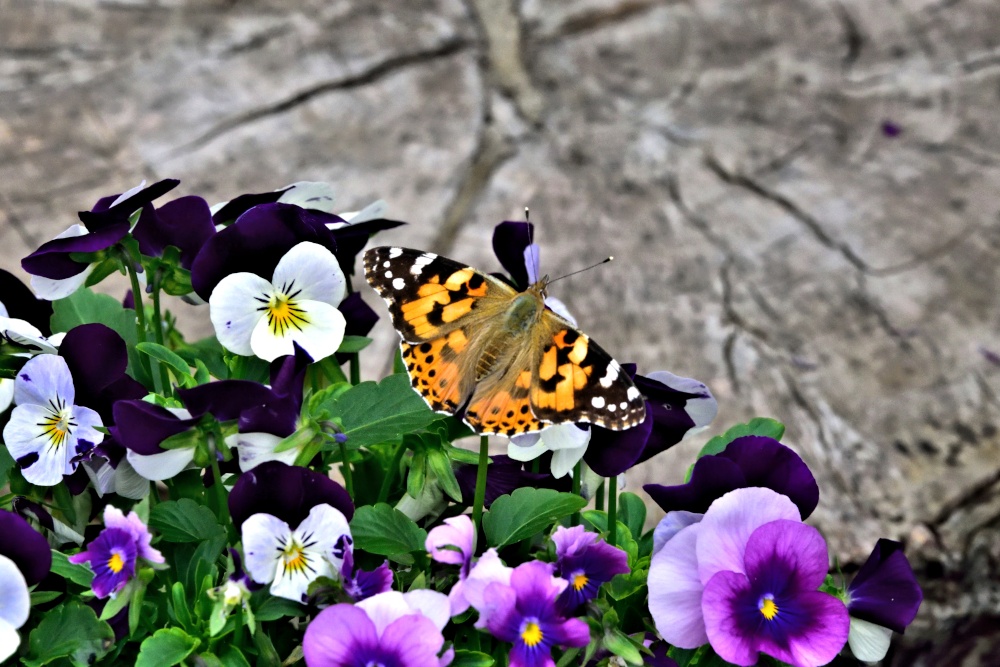 |
Painted Lady (Vanessa Cardui) in Whiteley Village The Painted Lady is a North African species that migrates to Great Britain and much of Europe in the summer. In some years this migration can be spectacularly large, covering almost every part of the British Isles and individuals can be seen almost any place where there are flowers, either wild or cultivated. However they cannot tolerate our winters so, even if they mate and oviposit, or pupate here, they do not survive. This picture appears in the following picture tours: |
 |
Purple Hairstreak (Favonius Quercus) Female by the Lake in Whiteley Village The Purple Hairstreak is our most common Hairstreak butterfly, although that does not make it common in overall terms. This small species favours Oak woodlands, where it spends most of its time up in the canopy, making it very difficult to spot and especially to identify. They so rarely come down to ground level that I very nearly missed seeing it among the wood chippings on one of our woodland paths and I wondered about the health of this specimen. It did fly off however, after I got this shot. This picture appears in the following picture tours: |
 |
6 spot Burnet Moth in Whiteley Woods The 6 spot Burnet (Zygaena filipendulae) is is a common day flying moth, black with 6 prominent red spots on each forewing. It mostly inhabits grasslands, but will also be seen on roadside verges and woodland rides. This picture appears in the following picture tours: |
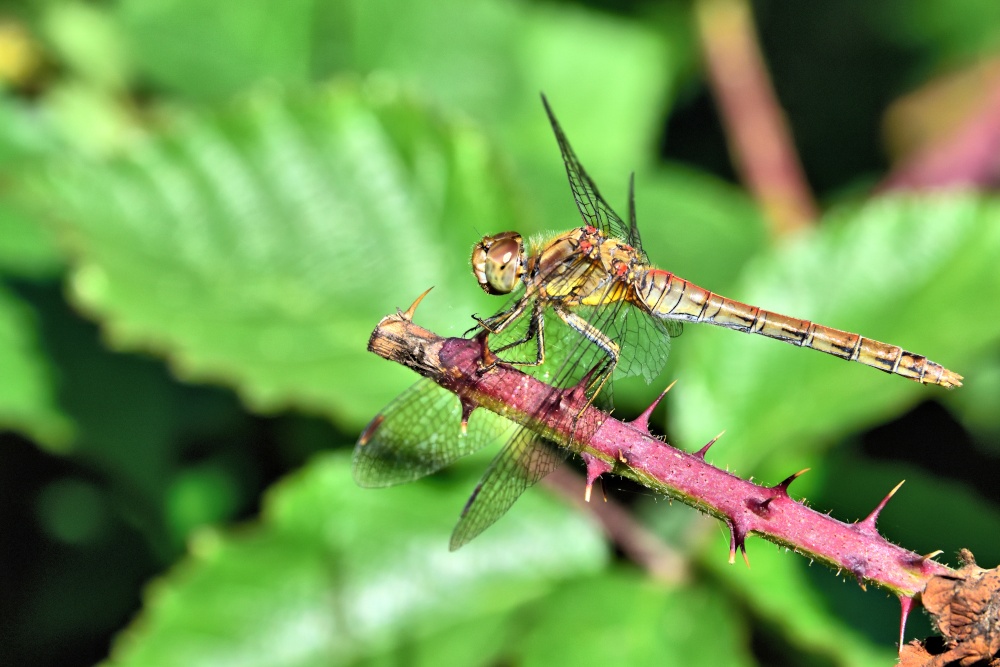 |
Common Darter (Sympetrum Striolatum) Semi-mature Female on a Bramble in Whiteley Woods I don't know why Dragonflies perch on Brambles, although in this case it's probably inexperience, as we can tell from her colouring that this female Common Darter is a very young adult. You can see that she has already had a piece torn out of her left hindwing, probably by landing on the very same plant, as dragonflies are such creatures of habit. Unfortunately there are no second chances with this type of incident and if she continues to use this perch she could become unable to fly even before obtaining her full adult colours. This picture appears in the following picture tours: |
 |
Southern Hawker (Aeshna Cyanea) Male in Whiteley Woods The Southern Hawker is a large solitary Dragonfly and is common in lowland England, recently spreading into Scotland. This species is unique in that it will approach anyone entering its territory and hover around to check you out, before returning to its business of looking for food and females to mate with. The females are patterned black & green throughout their length, whereas in the males the last half inch or so changes to black & blue. This picture appears in the following picture tours: |
 |
Large Red Damselfly (Pyrrhosoma Nymphula) Male Perched on a Leaf in Whiteley Woods The Large Red Damselfly is usually the first Odonata (Damselfly or Dragonfly) to emerge in the spring, often seen as early as March in the UK. It is also the most abundant here in Whiteley Woods and it's not uncommon to see 5 or 6 pairs ovipositing simultaneously, even in our small pond. There are only 2 red Damselfly species in Britain and they are easily distinguished apart from the size difference, by the abundance of black markings on the Large species being absent on the smaller one. This picture appears in the following picture tours: Camera Make: NIKON CORPORATION� Model: NIKON D810� |
 |
Emperor Dragonfly (Anax Imperator) Male in Whiteley Woods Emperor Dragonflies are rightly named as they are the fastest flying, most agile and most aggressive species in the UK, so I was having a tough time trying to photograph this male in flight, when suddenly along came another. Not surprisingly this lead immediately to a fight, with much clattering and buzzing of wings, but it wasn't long before this chap flew straight to ground and hid in the grass. I've never seen this kind of behaviour before, especially from an Emperor, so I think he sustained an injury, probably a bite. I got in quite close to take this shot, but I then thought I should leave him alone to recover. This picture appears in the following picture tours: |
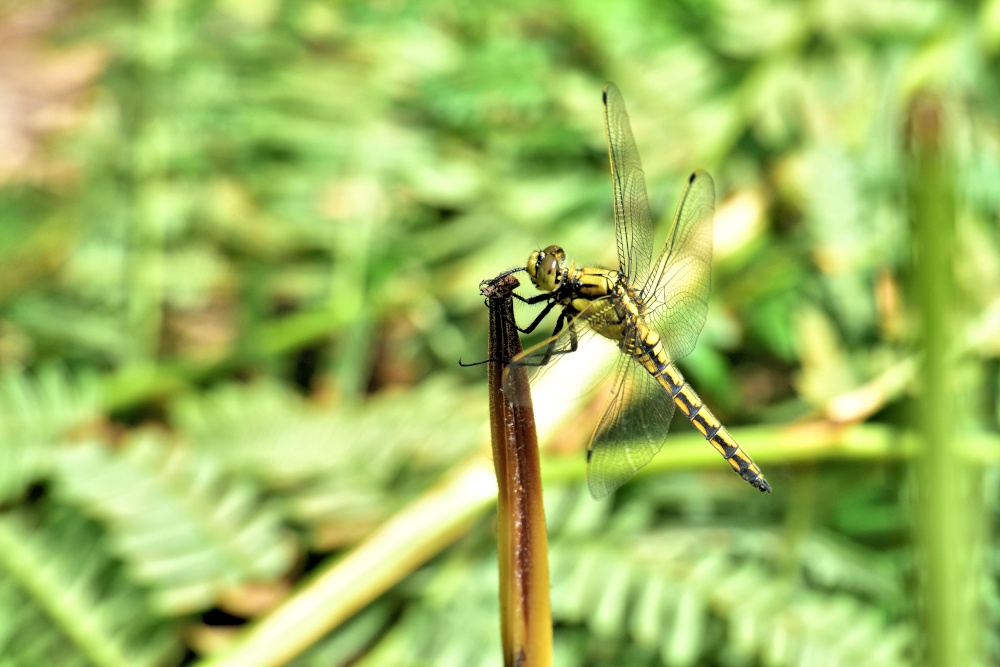 |
Black-tailed Skimmer (Orthetrum Cancellatum) Teneral Male in Whiteley Woods Black-tailed Skimmer Dragonflies are a good example of the dramatic change in appearance from teneral to fully mature males. Once mature this mostly yellow teneral will have a bright blue abdomen, changing to black for about the last half inch. The thorax will also darken to a very dark green. Several species that are not resident (don't breed) in Whiteley Woods spend their first month or so here, honing their flying and hunting skills, until they attain full adult colours, when they will return to their place of birth, hopefully to breed. This picture appears in the following picture tours: |
 |
Beautiful Demoiselle (Calopterix Virgo) Male in Whiteley Woods As with the female, the brown shading on the wings of this Beautiful Demoiselle tell us that this male is not yet fully mature. His wings will darken to black, possibly shading to clear over a short stretch at the inner and outer ends. They are also distinguished by their metallic blue body colour, as opposed to the female's metallic green. This picture appears in the following picture tours: |
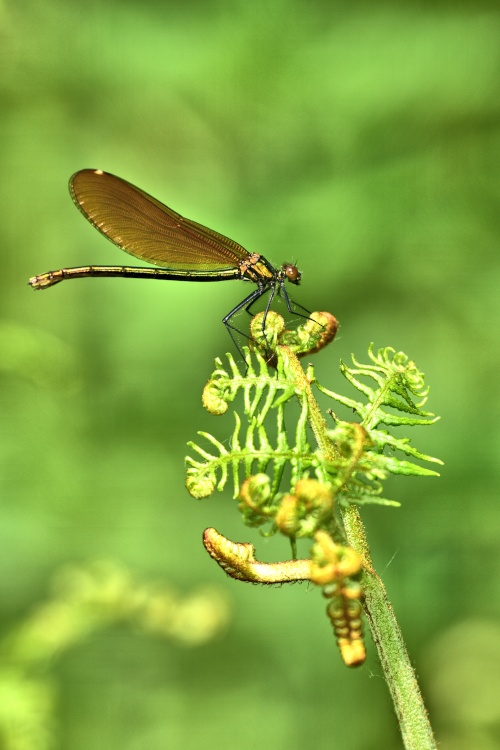 |
Beautiful Demoiselle (Calopterix Virgo) Female in Whiteley Woods The brown shading on the wings of this female Beautiful Demoiselle tell us that she isn't yet a fully mature adult. When she is, her wings will be almost clear, with a hint of green. We also know that she didn't emerge from her underwater life here, as Demoiselles only breed in fast flowing rivers and there are no such waterways here in Whiteley woods, but like most Dragonflies and Damselflies, as soon as they can fly they leave their place of birth and find shelter in a woodland a mile or two away. This is because any already fully mature males will chase and try to mate with the young females, even though they are not capable at this stage. This picture appears in the following picture tours: |